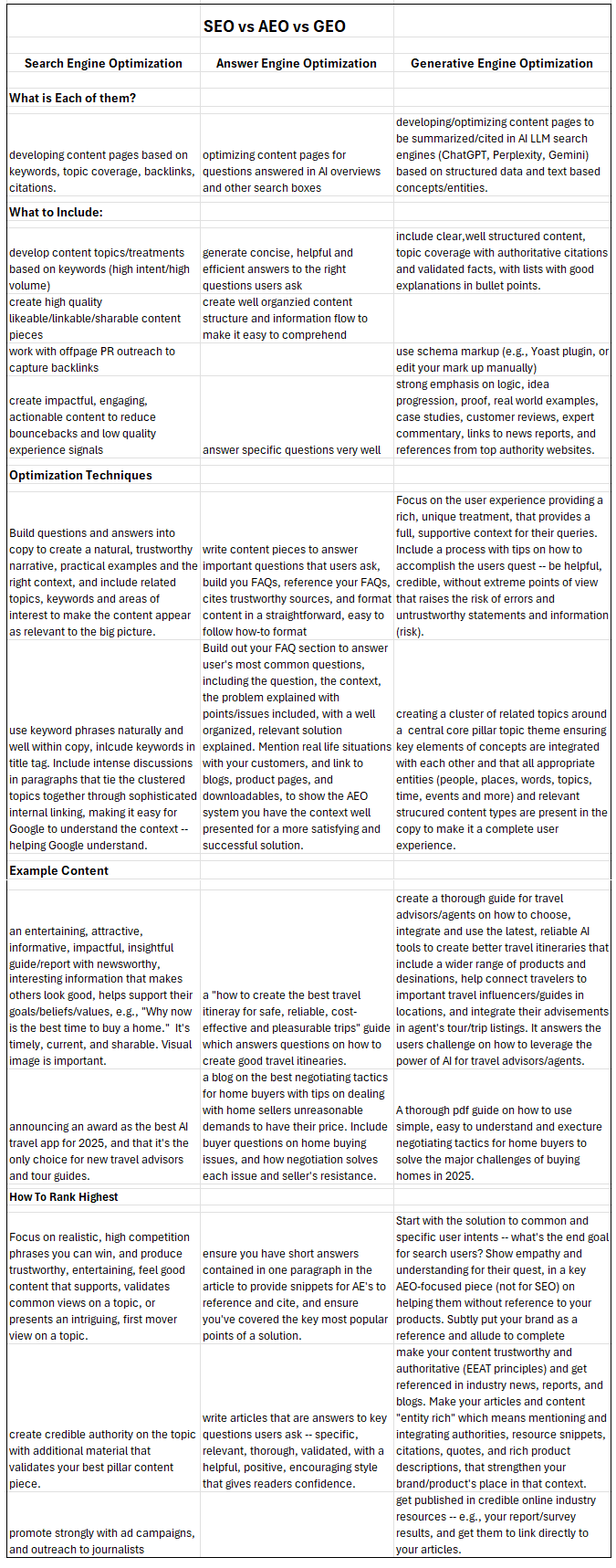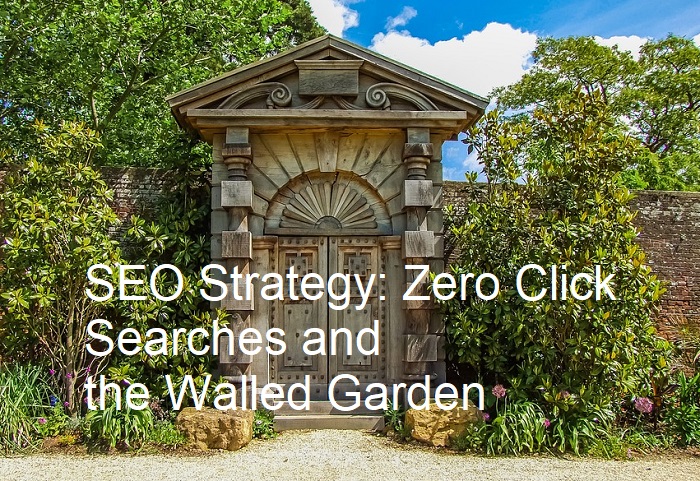Generative Engine Optimization (GEO)
It’s nothing short of a revolution in content marketing and search happening right now. A new type of search engine is growing in popularity and it’s presenting small business owners with a first-mover advantage.
It’s always wise to get a jump on technology waves. Did you miss any of them in the past?
As you’ll learn here, artificial intelligence-powered search engines are different to the Google you know so well. We’ll explore that here. If you’re going to draw AI search engine users to your website (which you must), your content has to resonate to what the AI LLMs are looking for in good content.
ChatGPT, Perplexity, Grok, Gemini and CoPilot are unique AI search engines. Each has their own unique way of answering search user’s queries. SEO and GEO are different disciplines and I’m happy to be with you on this journey into a new era of search.
Traditional search was built on links. GEO is built on language — from the post “How Generative Engine Optimization (GEO) Rewrites the Rules of Search” — Andreesen Horowitz.
GEO is an Extension of Your SEO and Content Strategy
You can think of GEO as an extension of your current content marketing and advanced SEO strategy. In fact, most search experts believe GEO techniques will only make your SEO more effective. You can create separate sets of content for SEO and GEO if you like, which might be wise, because you might get better results for both. But for now, let’s just delve into this exciting new realm of Generative search optimization — it might be the future of search. It’s going to accelerate to create big changes in how consumers and B2B buyers become educated, motivated and persuaded.
What is Generative Engine Optimization?
AI LLM GPTs answer search queries where users need better, faster and more understandable answers. The AI LLMs deliver comprehensive answers, summaries, or even entire articles to users. AI search engines are trained with a massive set of data scraped from the web and private databases (which is the base of their training model).
Generative Engine Optimization (GEO) is the modern playbook for making sure your small business brand is the trusted voice that AI chooses when answering their user’s questions. It is the crucial process of making your online content so clear, authoritative, and structured that AI systems, like Google’s AI Overviews or ChatGPT, select it to formulate the direct, definitive answer for a user’s query, ensuring your brand earns the “AI citation” rather than a hidden link.
Let’s answer first about how these AI LLM search engines are different from Google or Bing search engines. I had an extensive conversation with ChatGPT to get this interpretation:
AI LLMs differ from search engines because they don’t pull information directly from a live database of sources. Instead, their “knowledge” comes from patterns learned during training on vast amounts of text, which is compressed into the model’s neural network rather than stored as retrievable documents. When they answer a question, they generate text statistically rather than recalling a specific article. If citations are shown without live retrieval, they’re often just plausible fabrications based on how citations usually look. With retrieval-enabled systems, however, the model can query a real database or the web, summarize that content, and cite actual published resources.
Okay, let’s break down this strange phrase to make it understood.
- The generative part is what is generated by the AI Large Language Model and given to their search user. This material creates an information experience, and your content in part or whole, or by influence helps shape the success of the user’s search experience.
- The engine part is the decision-making core that interprets queries, selects from possible content, and generates responses to users.
- The optimization part is in how we design, organize and publish content to appeal to the AI LLM’s (e.g., ChatGPT) text-based ranking algorithm. That’s the component that decides whether your content is most significant out of all the text content in its database. Optimization also refers to making your content a great experience for visitors.
AI LLMs don’t use the term “ranking” but in essence, if your content appears in ChatGPT, we can conclude that it rated well enough to be shown. Out of the millions of documents it could have cited, it might decide to choose yours! GEO as part of your advanced content strategy, is about making your content the “real source of truth” so these AI LLMs will choose to reference and cite it.
Traffic is Low Currently, but Will Increase as the AI Engines Improve
Right now, traffic from ChatGPT, CoPilot, Gemini, Deepseek and Perplexity is low. However, it’s believed consumers will use these engines increasingly more. Thus traditional organic search engine traffic (Google, Bing, DuckDuckGo, Yahoo) may decrease slightly as time passes. Already zero click traffic is increasing and many websites are seeing lower traffic. But always remember, Google users are extremely loyal and there is something they prefer about Google search. And Google is changing it’s search engine, even integrating their AI LLM algorithm to create more value for users. We’ll see where this all goes!
If you like, you can read the posts on search generative experience, advanced SEO, and answer engine optimization to understand the broader context of what’s happening.
Here’s a breakdown in the difference between search engine optimization, answer engine optimization and generative engine optimization:

One of the reasons AI and GEO are so popular is that it’s understood that companies such as Google, Microsoft, OpenAI, and other tech monopolies prefer it over reality-based search. With AI systems, they can get more complete control over what people experience online, how its interpreted, and ultimately what people buy. So being divorced from reality helps them capture greater share of consumer wallet. GEO doesn’t offer big openings for us as yet, but it may be our only window into this closed network they will own.
Real Value and Opportunity in GEO for Small Businesses
The real value and opportunity of GEO are in its ability to:
- Enhance Visibility in a New Search Paradigm: As more users turn to AI-driven search for direct answers GEO ensures your brand remains visible and significant via content directly incorporated into AI-generated responses. This can lead to a “first-mover advantage.”
- Drive Qualified Traffic: When your brand is cited in an AI-generated answer, it signals authority and trustworthiness to the user. These searchers may be qualified customers, as through their Generative Experience, they learn that your company or products are most significant to their quest.
- Improve User Engagement and Experience: Generative AI aims to provide the. By optimizing content for GEO, marketers are inherently creating more user-centric content, addressing specific questions and providing value in an easy-to-digest format. It’s content the AI LLM considers most helpful, concise, for better answers to user queries. This leads to enhanced user engagement and satisfaction.
- Build and Solidify Brand Authority: AI models prioritize authoritative and trustworthy sources. By consistently producing high-quality, expert-backed, trustworthy, and well-structured content, we can establish your company as a market leader, increasing the likelihood of being cited by AI. This contributes to a stronger brand reputation and perceived expertise (E-E-A-T: Experience, Expertise, Authoritativeness, and Trustworthiness – good for all SEO efforts).
- Future-Proof Marketing Strategies: Generative AI is a fundamental shift in how people access and interact with information. Optimizing your GEO opportunity ensures your brand’s digital presence remains competitive and significant to consumers.
- Enables Hyper-Personalization at Scale: At an advanced level, Generative AI can analyze vast datasets to understand your customer’s preferences and behaviors, allowing marketers to create and deliver highly personalized content, offers, and recommendations. This can lead to increased conversion rates and stronger customer relationships.
How Are Content Marketers adapting to GEO?
Marketers are adapting to GEO by refining their content strategies to resonate with AI LLM GPTs generative experiences by:
- Prioritizing Content Quality and Authority: We shift away from a pure keyword focus to creating truly unique, valuable, comprehensive, accurate, and expert-driven content. This includes:
- Demonstrating E-E-A-T: Showcasing experience, expertise, authoritativeness, and trustworthiness through detailed author bios, citations, case studies, and linking to reputable sources.
- Unique Insights and Data: Developing original research, data, and perspectives that make content stand out and become a unique reference point for AI.
- Adopting a User-Centric and Conversational Approach:
- Answering Direct Questions: Creating unique content (Using AI too) that directly and concisely answers common user questions, often in FAQ formats or “how-to” guides.
- Conversational Language: Writing in a natural, conversational tone that mimics how users interact with AI.
- Understanding User Intent: Moving beyond simple query keywords and topic treatments to understand user intent to create more personalized content.
- Structuring Content for AI Interpretation:
- Clear Headings and Subheadings: Using logical content structures (H1, H2, H3, etc.) to make information easily scannable and digestible for AI algorithms.
- Bullet Points and Lists: Presenting information in easily extractable formats.
- Structured Data (Schema Markup): Implementing schema markup (e.g., FAQ schema, Product snippets, Q&A) to help AI models understand the context and purpose of content.
- Internal Linking: Creating interconnected content hubs to signal relevance and authority across topics.
- Optimizing for Multi-Modal Content: Generative AI can accept and synthesize information from various formats (your unique content creations). Marketers are diversifying their content beyond just text to include:
- Images and Infographics: Optimizing images with descriptive file names and alt text and creating visual content that AI can parse and cite.
- Videos: Developing video content with clear transcriptions and optimizing for search.
- Podcasts and Audio Clips: Expanding reach to users who prefer listening.
- Evolving Keyword Strategies:
- Long-Tail and Conversational Keywords: Focusing on longer, more specific, and natural language queries that reflect how users interact with AI.
- Semantic Keywords: Including related terms and synonyms to provide comprehensive topic coverage, as AI looks for contextual meaning rather than just exact matches.
- Topic Clusters: Organizing content around broad topics with interconnected articles to establish comprehensive authority and support key pillar content (advanced SEO).
- Monitoring and Adapting: The GEO landscape is rapidly evolving. Marketers are:
- Tracking AI Citations and Mentions: Using new tools and analytics to monitor how often their brand or content is cited in AI-generated responses.
- Staying Updated with Algorithm Changes: Closely monitoring updates from generative AI providers and search engines (or trying to interpret updates from available info).
- Experimenting and Iterating: Continuously testing different content formats, structures, and strategies to see what performs best in AI environments.
In my next post, I’ll dive deeper into Generative Experience Optimization.
At the end of the day, this is all part of advanced search engine optimization and how you can stay competitive in a very complex search marketplace.
Combine great content strategy with great SEO and you’re helping your company thrive and grow. See more on search engine optimization services.
Title Image Courtesy of Stockcake







